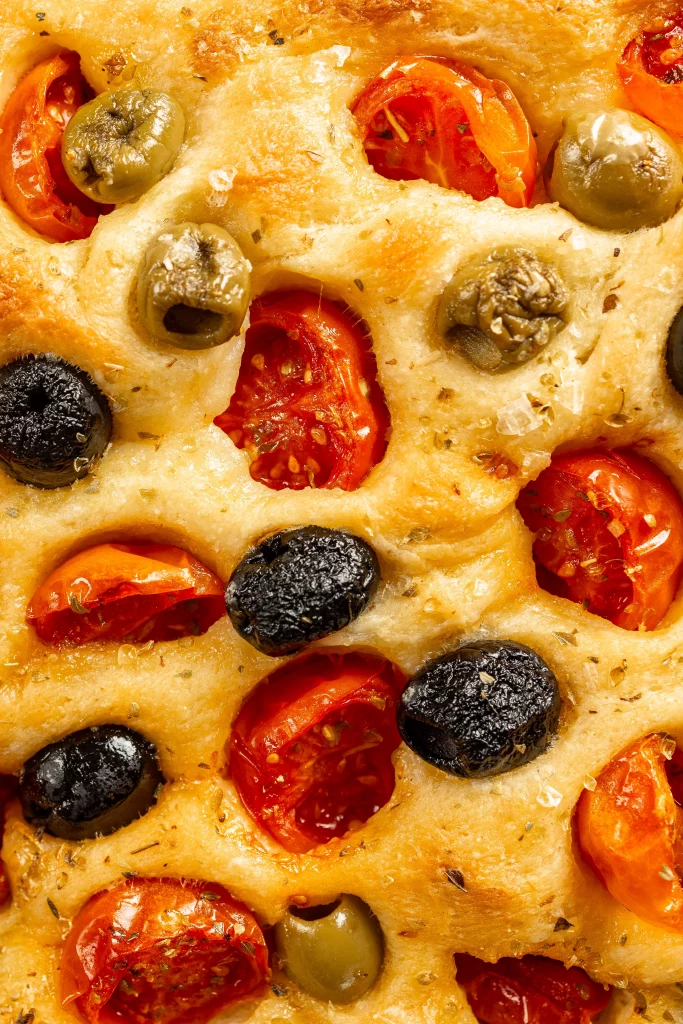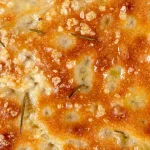This fluffy and savory flatbread from Pulia makes a satisfying snack in the middle of the afternoon or a delicious appetizer for happy hour. In Italy it’s called focaccia, or flatbread, and comes from Bari, the “heel” of Italy. Bake it once, and you will fall in love with it after your first bite!
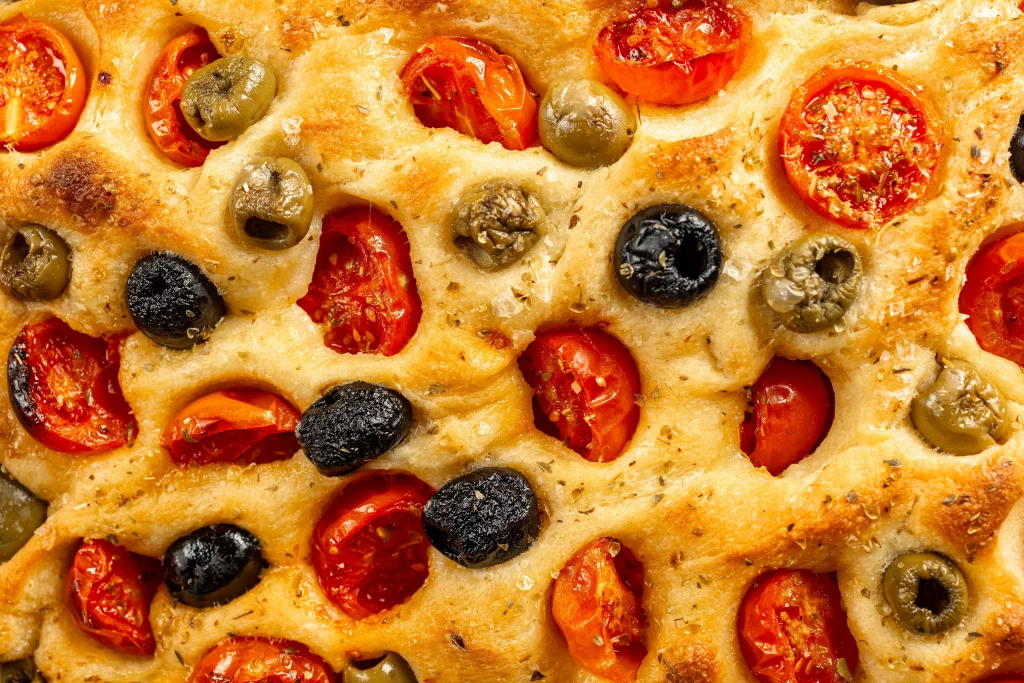
What does Apulian flatbread go with?
Everything! There’s something magical about this flatbread—everybody loves it, so get your oven ready to bake it over and over again. In Apulian bakeries, it is made early in the morning where its fragrance pleasantly floats through the streets.
This flatbread fits any time of the day; it‘s good for lunch, dinner, or a snack in between meals. Students wrap this flatbread in a piece of brown paper and take it to school. This flatbread is perfect from dawn till dusk. Just imagine what might happen at your house after your neighbors get a whiff of this heavenly smell. They will surely come knocking on your door.
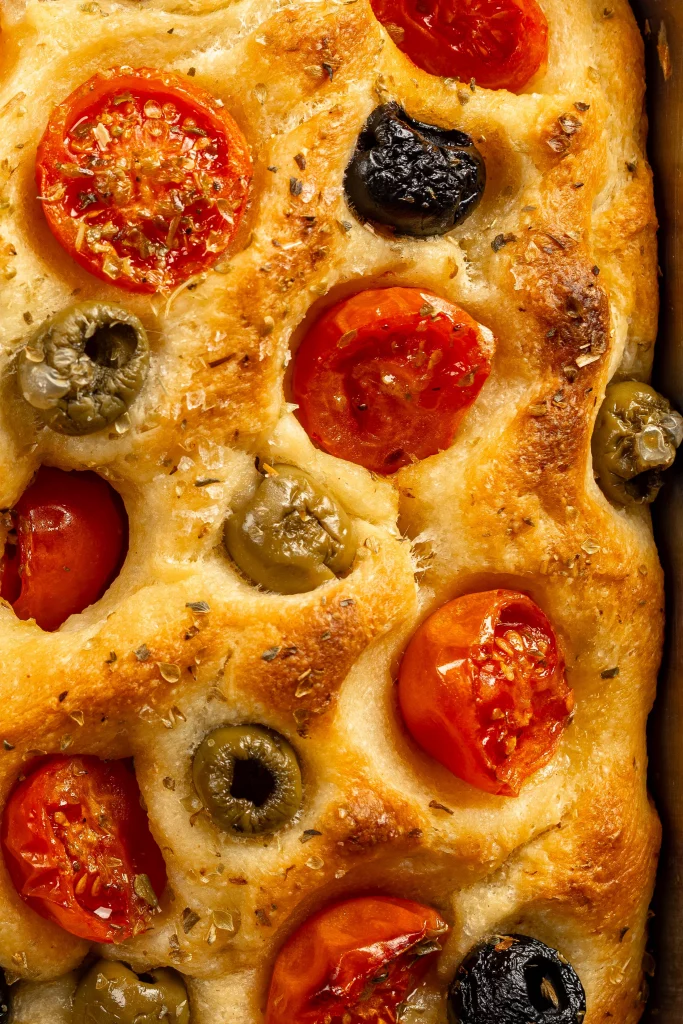
Is it tasty?
I can’t tell you how appetizing this flatbread really is, so the only way to find out is to make it and try to take only one bite. On that first bite, your teeth will sink into a super fluffy, well-leavened taste of magic that you will fall in love with immediately.
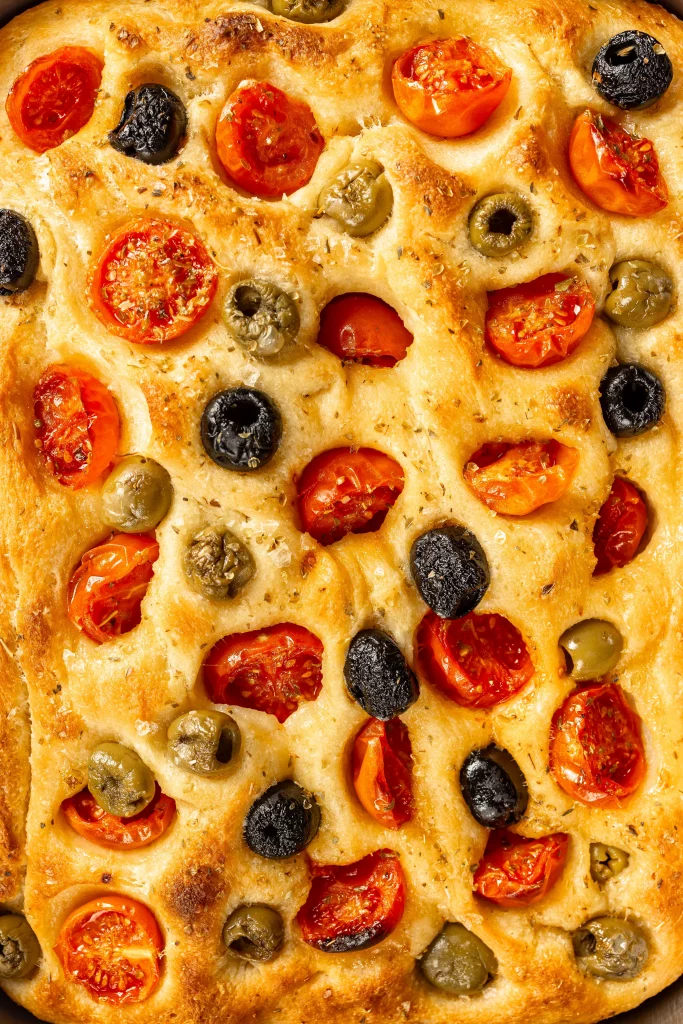
The recipe calls for a slightly unusual dough
- Potatoes are essential in this recipe because their starch makes the dough fluffy and soft. Too many potatoes make the dough difficult to be kneaded and baked correctly. However, if you don’t add any potatoes, you will have a delicious flatbread, but it won’t be as fluffy as the Apulian flatbread. Potatoes keep it soft for up to 3 – 4 days and are important to this recipe;
- Mother yeast is a yeast starter that you culture yourself from a starter. The genuine “registered” recipe from Bari only calls for mother yeast, but it can easily be replaced with dried yeast;
- Finely ground semolina makes the dough more rustic, which along with all-purpose flour helps the rising process and imparts a yellowish hue;
- Tomatoes: Fresh cherry tomatoes are cut into halves. Tomatoes make your flatbread pleasantly red.
- Dry oregano and olives give the finishing touch of class. Black olives, such as Kalamata, are preferred but also green ones could be used.
- Only extra virgin olive oil can be used in the dough and to grease the baking tray. It delivers a strong and unique taste; moreover, it makes the surface deliciously crunchy with a soft and fluffy center. Don’t use any other oil.
Your experience with this flatbread
Every bite has a different taste and texture. The middle part tastes deliciously of olives and tomatoes and the golden-brown edges are very savory and crunchy. The natural juices from the tomato make the texture soft and moist, while the bottom crust, soaked with extra virgin olive oil, is the crunchiest and most tempting part of all. It’s a symphony of different tastes where you experience three different kinds of flatbread in one bite.
Before getting started
It is a simple recipe, but the final results depend on several factors; a few tricks make the difference.

- Sift the different flours before adding the water.
- Always keep yeast far from the salt. I usually mix the all-purpose flour with the semolina. The final texture varies, but the first dough has to be soft and smooth. If you combine it with the yeast and the salt, you will spoil it.
- Don’t knead the dough too much; otherwise, it will get too hard. The flatbread dough must be quite malleable so that it can be placed in a well-oiled baking tray and flattened and stretched with oiled fingers.
- Add lukewarm water slowly, not all at once.
- Put the dough directly on an oiled baking tray; then flatten it with your hands. Press the dough gently so as to not tear it or make holes.
- Prepare the tomatoes, black olives, extra virgin olive oil, oregano, and salt beforehand, and allow them to rest and combine flavors. The topping is a bit tricky. Apulian flatbread doesn’t call for any loose ingredients; they must come together as a whole.
- This flatbread must be golden-brown. Use a cast iron or aluminum baking tray for perfect results.
Apulian flatbread with tomatoes
Ingredients
- 1¼ cups of all-purpose flour (200g)
- 1¼ cups of finely ground semolina (200g)
- 5 ounces of Yukon Gold potatoes diced (150g)
- 1 full tablespoon of dry yeast
- 10 tbsp of lukewarm water (150ml)
- ½ tsp of sugar
- 1 full teaspoon of salt
- 11/3- 1 2/3 cups of cherry tomatoes (250-300g)
- 15-20 black olives
- Coarse salt
- Dry oregano to taste
- Extra virgin olive oil to taste
Instructions
- Peel and dice the potatoes; cook them in boiling water for 20-25 minutes or until tender;
- Let the potatoes cool down a little and then mash or rice them for a more uniform texture;
- Dissolve the yeast in 10 tablespoons (150ml) of lukewarm water and add the sugar to active it;
- Sift the two types of flour together; add the salt and the mashed potatoes;
- Mix it all with a stand mixer, like a KitchenAid, fitted with a dough-hook attachment or by hand on a flat surface. Mix it until smooth and even;
- Pour in the water along with the yeast and knead it carefully;
- Gradually add 2 tablespoons of oil, one at a time;
- Knead it with your hands or in a stand mixer at medium speed; don’t worry if the dough doesn’t come together, it will after you pour in some more water;
- Pour in the water until it’s a soft and almost sticky mixture;
- Knead it a couple of minutes until it becomes stretchy; the dough should release easily from the side of the bowl and twist around the hook; just don’t knead it too long;
- Pour it onto a floured surface and sprinkle the dough and your hands with all-purpose flour; shape the dough into a rectangle and then fold the two sides into the center and then fold it again laterally;
- When a smooth dough has formed, make a ball with floured hands and place it in the oiled bowl;
- Cover the bowl with plastic wrap and let it rise until the dough has tripled in volume;
- In the meantime, halve the tomatoes and dress them with salt, oil, and oregano; set them aside; a little liquid will be released;
- Put the dough into an oiled round 10-inch (26-28cm) pan; flatten it with the tips of your well-oiled fingers;
- Place the tomatoes and black olives spaced evenly on the surface and press them into the dough. Pour a little tomato liquid for a more flavorful taste;
- Generously season it with extra virgin olive oil, dry oregano, and coarse salt;
- Let the flatbread rise for one hour or until it has doubled in volume; the tomatoes and olives will have sunk into the dough;
- Pre-heat the static oven to 400°F (200°C) and bake for about 25 minutes: first place the tray onto the lower rack for 10 minutes; then move it to the middle for the remaining 15 minutes;
- Check for doneness: the edge should be crunchy- take it out of the oven and let cool down a bit before serving. This scrumptious flatbread is ready to be eaten either hot or cold.
How to store it
Let your flatbread cool down completely—it will take about 2 hours—then wrap it in plastic wrap. It will stay fresh and fluffy for up to 3 days at room temperature. It should not be frozen.

